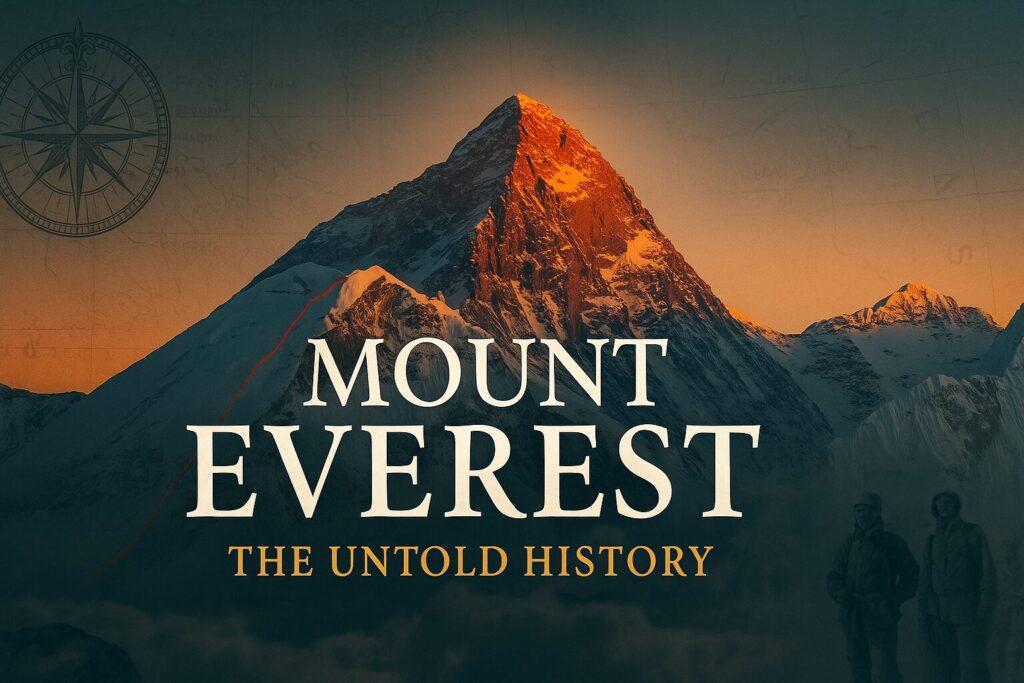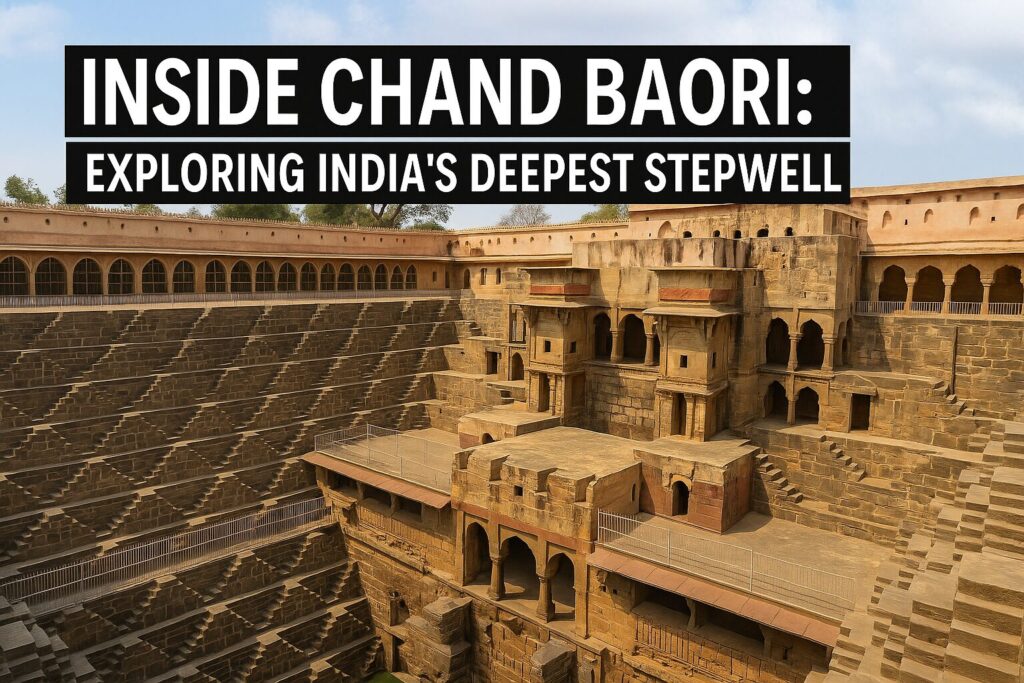Mount Everest: The Untold History Behind the World’s Tallest Peak explores hidden stories, early expeditions, cultural myths, and the rise of tourism around mount everest height. Discover why this legendary summit continues to inspire and challenge climbers worldwide.
Table of Contents
Introduction
Mount Everest, towering at a staggering 8,848.86 meters (29,031.7 feet), holds the distinction of being Earth’s highest point above sea level. Its sheer scale has inspired awe for centuries. While many know mount everest height as a record-breaking figure, fewer people realize that Everest is also a tapestry of hidden stories, cultural significance, and decades of geopolitical intrigue.
Climbers from around the globe dream of standing atop its icy summit, but Everest is far more than a mountaineering challenge. From sacred legends passed down through Himalayan communities to the daring expeditions that turned the mountain into a symbol of human ambition, Everest’s history is as layered as its rock strata.
In this article, we will uncover the untold narratives behind mount everest height, revealing how myth, politics, tragedy, and triumph have shaped the world’s tallest peak into an enduring icon.
The Discovery of Mount Everest: Naming the Giant
Long before satellites could measure every contour of the Himalayas, surveyors in the 19th century embarked on an ambitious mission to chart the peaks of British India. This effort, known as the Great Trigonometrical Survey, would eventually reveal mount everest height as the highest point on Earth a fact unknown to the Western world until 1856.
The story begins with Sir George Everest, the Surveyor General of India from 1830 to 1843. Though he never actually laid eyes on the mountain, his meticulous work laid the foundation for its measurement. In 1852, Radhanath Sikdar, an Indian mathematician and surveyor, calculated that “Peak XV” surpassed all previously recorded elevations. The initial estimated height 29,002 feet was astonishingly close to modern measurements, proving the team’s precision with the limited tools of their era.
In 1865, Andrew Waugh, Everest’s successor, officially named the peak Mount Everest to honor his predecessor. Ironically, this decision overlooked local names:
- Chomolungma, meaning Goddess Mother of the World in Tibetan
- Sagarmatha, meaning Forehead in the Sky in Nepali
These traditional names remain in use and carry deep cultural resonance, reminding us that Everest was sacred long before it became a mountaineer’s prize.
This discovery was not simply a geographical milestone. It marked the start of the mountain’s transformation from an enigmatic giant to a global symbol of exploration and aspiration. As the surveyors measured mount everest height, they were also measuring the limits of human curiosity.
Before the Climbers: Everest in Ancient Myths and Local Culture
Long before British surveyors declared mount everest height to be the tallest in the world, local communities revered the mountain as a living presence. For centuries, Everest was a place of profound spiritual significance a domain of deities, not explorers.
In Tibetan culture, Everest is known as Chomolungma, Goddess Mother of the World. According to Sherpa beliefs, the mountain is the home of Miyolangsangma, a benevolent goddess of abundance and good fortune. Climbers still receive blessings from Buddhist lamas before expeditions, hoping to appease Miyolangsangma and secure safe passage.
Among the Sherpas and Tibetan Buddhists, Everest is:
- A place for ritual offerings, especially at mount everest base camp, where climbers build stone cairns called chortens adorned with prayer flags.
- A boundary between the earthly and the divine, symbolizing the ultimate threshold humans should cross only with respect.
- An embodiment of impermanence and humility. Even the tallest mountain is vulnerable to time and change, reminding people of life’s transience.
Nepali traditions also attribute cosmic power to the peak. The name Sagarmatha (Forehead in the Sky) captures the sense that Everest touches realms beyond human comprehension.
When modern climbers describe the mountain’s “aura,” they echo ancient perceptions. For Sherpas, the mountain is not simply a challenge; it is a sacred entity whose mood can shift unexpectedly. These cultural layers are often overshadowed by records of mount everest climbers, but they are crucial to understanding why Everest is more than a geological marvel.
This deep reverence helps explain why early local guides were hesitant to climb to the summit. To them, standing atop Everest was not a trophy it was a transgression. This tension between sacred landscape and Western conquest set the stage for the first expeditions.
The Race to the Summit: Early 20th Century Expeditions
Once the British had measured mount everest height, it was only a matter of time before climbers set their sights on reaching the top. The early 20th century became an era of audacious attempts and heartbreaking losses a dramatic race that captured the world’s imagination.
The first expeditions began in the 1920s. Nepal was closed to foreigners, so climbers approached from Tibet. In 1921, the British organized a reconnaissance mission to map potential routes. This set the foundation for the famous expeditions that followed.
One name became synonymous with this era: George Mallory. A charismatic Englishman, Mallory joined the 1922 and 1924 attempts. When asked why he wanted to climb Everest, he famously replied, “Because it’s there.”
The 1922 expedition marked the first time humans climbed above 8,000 meters. But tragedy struck when an avalanche killed seven Sherpa porters a grim reminder that the mountain demanded respect.
In 1924, Mallory returned with Andrew “Sandy” Irvine, determined to reach the summit. On June 8, they were last seen alive, climbing high on the northeast ridge. Whether they reached the top before perishing remains one of mountaineering’s greatest mysteries. When Mallory’s body was finally discovered in 1999 by a team led by Conrad Anker, it was still impossible to tell if he had summited.
These early expeditions were feats of courage and endurance:
- Climbers wore heavy wool garments and rudimentary oxygen systems.
- Maps were incomplete, and weather predictions were guesswork.
- The psychological burden of isolation at extreme altitude was immense.
Yet these attempts laid the groundwork for all who followed. They proved that the summit was within human reach, setting the stage for a historic breakthrough decades later. Every climber today from tourists trekking to mount everest base camp to elite alpinists traces their steps in part to Mallory’s vanished footprints.
1953: The First Successful Ascent by Hillary and Tenzing
By the early 1950s, the dream of reaching the summit of Everest had become an international obsession. Several expeditions came close, but none had yet stood on the highest point. In 1953, that changed forever when mount everest height was finally conquered by an extraordinary partnership between a New Zealand beekeeper and a Sherpa from Nepal.
Sir Edmund Hillary and Tenzing Norgay were part of a large British expedition led by Colonel John Hunt. Unlike earlier attempts, this team was meticulously organized and benefited from improved equipment, better nutrition, and more advanced oxygen systems.
The expedition faced formidable challenges:
- Blizzards and bone-chilling mount everest temperature that could plunge below -40°C.
- The Khumbu Icefall, a shifting labyrinth of crevasses and towering ice blocks.
- The thin air above 8,000 meters, known as the Death Zone, where the human body begins to deteriorate.
On May 29, 1953, Hillary and Tenzing made their final push. They followed the South Col route, carefully ascending the icy slopes to the Southeast Ridge. At 11:30 a.m., they reached the summit, becoming the first confirmed humans to stand atop mount everest height.
Hillary described the moment with characteristic modesty: “I just shook hands with Tenzing and we thumped each other on the back until we were almost breathless.” Tenzing later buried some sweets in the snow as an offering to the gods, honoring his cultural beliefs.
This achievement resonated far beyond the climbing world:
- The news reached London on the morning of Queen Elizabeth II’s coronation, symbolizing a new era of British accomplishment.
- Tenzing Norgay became a hero across Nepal and India, representing Sherpa resilience and skill.
- The success inspired a surge of interest in Himalayan exploration and sparked decades of subsequent expeditions.
Hillary and Tenzing’s triumph was not merely about reaching the top; it was a testament to partnership across cultures, innovation in mountaineering, and the enduring allure of the unknown. Their story transformed Everest from a remote enigma into the ultimate proving ground for human aspiration.
Forgotten Heroes: Unsung Figures in Everest’s Climbing History
While Hillary and Tenzing are rightly celebrated, the ascent of mount everest height has always depended on countless individuals whose names rarely make headlines. These forgotten heroes porters, Sherpas, support staff, and lesser-known climbers have shaped Everest’s legacy just as profoundly.
Among them was Ang Tharkay, who guided multiple early expeditions and played a critical role in supporting Eric Shipton’s reconnaissance in the 1930s and 1940s. His navigation skills and deep knowledge of the mountain were indispensable long before Tenzing’s ascent.
Another remarkable figure is Pasang Lhamu Sherpa, the first Nepali woman to reach the summit in 1993. Tragically, she died during the descent, underscoring the risk that every climber regardless of fame must face on Everest.
Other unsung contributors include:
- The Icefall Doctors: A specialized team of Sherpas who fix ladders and ropes across the deadly Khumbu Icefall each season, making it possible for hundreds of climbers to pass safely.
- Wang Fuzhou, Gongbu, and Qu Yinhua: The Chinese climbers who, in 1960, claimed the first ascent via Everest’s challenging north face an achievement long overlooked outside China.
- Junko Tabei: In 1975, she became the first woman to summit Everest, breaking gender barriers and inspiring generations of female mountaineers.
Many Sherpas have climbed Everest dozens of times. Kami Rita Sherpa currently holds the record with 30 ascents as of 2024 a feat almost unimaginable to the early pioneers.
Their contributions highlight a fundamental truth: no climber reaches the top alone. Even today, commercial expeditions rely on the expertise, stamina, and quiet heroism of local guides and support teams.
As the number of mount everest climbers has grown, so too has the recognition that the mountain’s history belongs to more than just the famous names. It is a collective achievement, built by countless hands and hearts.
Deadly Ambition: Disasters That Shaped Everest’s Legacy
While mount everest height inspires dreams of glory, it has also been the stage for some of mountaineering’s most harrowing tragedies. Over 300 climbers have lost their lives on its slopes, and each disaster has left an indelible mark on the mountain’s history.
One of the earliest large-scale tragedies struck in 1922, when an avalanche buried seven Sherpa porters during the first attempt to climb above 8,000 meters. This grim event foreshadowed the hazards that would define Everest expeditions for decades.
Perhaps the most infamous disaster occurred in 1996, immortalized in Jon Krakauer’s book Into Thin Air. That season, a deadly combination of hubris, overcrowding, and sudden storms turned triumph into catastrophe.
Key details of the 1996 disaster:
- Over 30 climbers were caught near the summit during a blizzard.
- Eight people died within a single 24-hour period.
- The event highlighted how commercialization and “summit fever” could overwhelm even the most seasoned guides.
More recently, in 2014, an ice serac collapsed in the Khumbu Icefall, killing 16 Sherpas in an instant an event that underscored the disproportionate risk borne by local workers. In 2015, a massive earthquake triggered avalanches that swept through mount everest base camp, claiming 22 more lives.
These tragedies have led to important changes:
- Improved weather forecasting and early warning systems.
- Stricter regulations on the number of permits issued each season.
- Better training and safety protocols for climbers and guides.
Yet Everest remains perilous, partly because mount everest temperature and unpredictable weather can turn routine climbs deadly in minutes. The risks are compounded by the “Death Zone” above 8,000 meters, where oxygen deprivation slowly degrades judgment, strength, and survival instincts.
These disasters remind us that Everest is no ordinary mountain. Its lure is matched only by its capacity for unforgiving extremes, and every climber must weigh ambition against respect for forces beyond human control.
Everest in the Cold War and Beyond: Political Symbolism on the Summit
While climbers have always been motivated by personal ambition, the conquest of mount everest height has also been woven into the fabric of global politics. During the Cold War, Everest became a symbolic battleground where nations measured their prestige against the ultimate backdrop: the roof of the world.
In 1960, a Chinese team led by Wang Fuzhou, Gongbu, and Qu Yinhua made what they declared the first successful ascent from the north face. The Chinese government widely publicized this climb as proof of national strength, though it was met with skepticism abroad due to limited photographic evidence. Decades later, many mountaineering historians came to recognize the achievement as genuine, underscoring how politics often overshadowed facts.
Similarly, the 1975 Chinese expedition, which placed a large tripod survey marker on the summit, was as much about asserting territorial claims over Tibet as it was about scientific measurement of mount everest height. China’s official elevation data remained a point of contention for years until Nepal and China jointly remeasured the mountain in 2020.
Western nations also used Everest climbs to project influence:
- India organized expeditions in the 1960s to demonstrate technological and organizational prowess.
- The United States sent climbers as part of broader diplomatic efforts in Nepal, framing their ascents as peaceful cultural exchanges.
- In 1978, Reinhold Messner and Peter Habeler reached the summit without supplemental oxygen a feat that shifted the climbing paradigm from geopolitical symbolism to human endurance.
Even in recent decades, Everest has remained a canvas for political statements. In 2008, China closed access to the mountain from Nepal temporarily to ensure the Olympic torch could be carried to the summit without protests over Tibet. This sparked debate about the balance between sport, sovereignty, and free expression.
These episodes show that mount everest base camp and the summit itself have often been more than geographic locations they have been platforms where nations stage their rivalries and ambitions. In this way, the mountain has reflected not only the limits of human physiology but also the shifting currents of world affairs.
The Commercial Era: How History Gave Way to Tourism
In the decades following the first ascent, the meaning of mount everest height began to shift. What was once the domain of elite alpinists and national expeditions gradually opened to commercial climbers, adventure seekers, and high-paying tourists. By the 1990s, Everest had entered the commercial era and it hasn’t looked back since.
The turning point came in 1985, when Dick Bass, a wealthy businessman with little mountaineering experience, summited Everest with professional guide David Breashears. This climb inspired the now-common “Seven Summits” goal and proved that, with enough support and money, even non-professionals could reach the world’s highest peak.
By the early 2000s, the transformation was undeniable:
- Dozens of guiding companies began offering full-service packages, including Sherpa support, oxygen bottles, fixed ropes, and even satellite Wi-Fi.
- The cost of climbing mount everest height ranged from $30,000 to $100,000+ per person.
- Crowds became so dense that climbers sometimes waited in traffic jams on narrow ridges near the summit.
This boom led to several critical issues:
- Overcrowding: In May 2019, a viral photo showed a “human traffic jam” just below the summit. That season saw 11 deaths, many attributed to long delays in the Death Zone.
- Environmental degradation: Tonnes of trash, abandoned gear, and even human waste accumulated on Everest’s slopes and around mount everest base camp.
- Exploitation of Sherpas: While essential to nearly every summit, Sherpas often took the greatest risks for comparatively little pay.
However, the commercial era also brought positive change:
- Increased access for climbers from diverse backgrounds, including more women, people with disabilities, and climbers from countries with little mountaineering tradition.
- Technological advancements in gear, weather forecasting, and communication that made climbs safer and more efficient.
- Eco-cleanup expeditions and awareness campaigns, such as the ones led by Dawa Steven Sherpa, aimed at preserving the mountain for future generations.
Mount Everest now welcomes over 800 summiteers per year, but the experience has changed dramatically from the days of Hillary and Tenzing. The mountain is no longer just a frontier it’s a market. For better or worse, history has given way to high-altitude tourism.
Conclusion: Why Everest’s History Still Echoes Today
Mount Everest is more than the sum of its elevation or its breathtaking views. While mount everest height remains an unmatched geographic milestone, its story is one of human ambition, cultural meaning, and global evolution. From sacred mountain to scientific curiosity, from imperial prize to commercial destination, Everest has reflected every era it has passed through.
The legacy of Everest is not just written in records and death tolls, but in the deeper truths it reveals:
- That exploration can unify people across borders, as in the partnership between Hillary and Tenzing.
- That ambition must be tempered with humility an unchanging lesson the mountain teaches climbers every year.
- That Everest is as much a stage for spiritual reverence and cultural identity as it is for adventure sports.
Even today, new chapters are being written. Mount everest base camp remains a bustling crossroad for adventurers, scientists, and filmmakers. Climate researchers track glacial melt to understand global warming. Sherpa voices are gaining strength in discussions about safety, wages, and the ethics of high-altitude tourism. Meanwhile, mount everest temperature fluctuations and unpredictable weather challenge even the most high-tech expeditions.
And through all of this, Everest endures.
To understand Everest is to explore the intersection of nature, mythology, history, and human will. Whether you’re a climber chasing the summit or a dreamer watching from afar, the story of mount everest height is ultimately a mirror reflecting both our greatest strengths and deepest vulnerabilities.
Its untold history isn’t just about what lies behind us. It’s also about what lies ahead.





